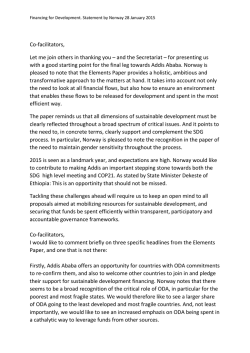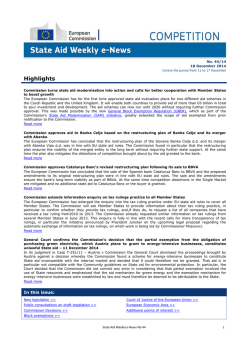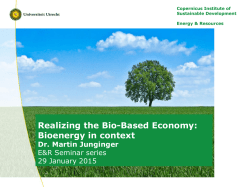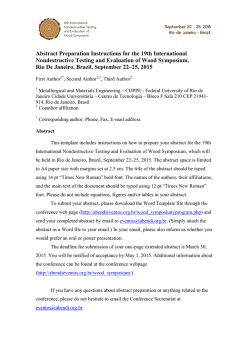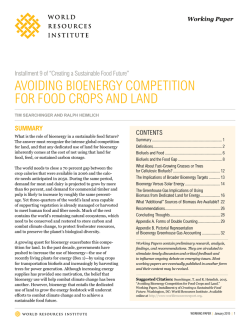
Norway (preliminary) - IEA Bioenergy Task 40
IEA Bioenergy task 40 – Country report 2013 for Norway Erik Trømborg Department of Ecology and Natural Resource Management Norwegian University of Life Sciences P.O Box 5044 1432 Ås Norway [email protected] JANUARY 2015 Task 40: Sustainable International Bio-energy trade 1 EXECUTIVE SUMMARY This report is a part of the work of IEA Bioenergy Task 40 working group-“Sustainable International Bioenergy Trade: Securing Supply and Demand” and gives a picture of the situation regarding bioenergy in Norway for the year 2013. Previous country reports for Norway are available at ww.bioenergytrade.org. Norway has large resources of oil and gas. Oil and gas extraction including services accounted for 20% of GDP in Norway in 2013, but is expected to decline in the coming years as a result lower prices and less available resources. The production of hydro electric power is also high in a European scale; the Norwegian production corresponds to about 40% of the production in EU 27. The net domestic energy consumption is only about 10 % of the production of primary energy carriers. Bioenergy constitutes 7% of the domestic consumption, electricity 51% and fossil fuels 42%. Norway’s targets for GHG emissions and implementation of the EU directive regarding the use of energy from renewable resources (RES) with a RES target of 67.5% by 2020, has resulted in new policy means for renewable energy. One important measure to fulfil the renewable energy targets is the establishment of a joint Norwegian-Swedish electricity certificate market in 2012 that will result in 13TWh new renewable power product by 2020, which corresponds to a 1015% annual increase. The parliament has also adopted a resolution asking the Government to introduce a ban on heating based on fossil fuels in households and for base loads in other buildings in 2020, and a resolution asking the Government to establish a goal for energy efficiency measures in buildings. The national target of 50 PJ (14 TWh) increased use of bioenergy by 2020, almost a doubling of the current production is still in place. Statistics Norway reports the gross biomass consumption in 2013 to be 56.2 PJ/15.6 TWh including biomass use in district heating. About 40% of the consumption is heat produced in wood stoves in private households, 15% is biomass in district heating and 25% is use of biomass for internal heating and drying in industries (mainly forest industries) and 10% is use of biofuels in road transport. Warmer winters and more use of heat pumps have reduced the fire wood consumption in private households the last years. The industrial use of bioenergy is reduced by 50% from 2011 to 2013 due to close down of pulp and paper plants. The use of biomass in district heating is increasing steadily. About 10% of the bioenergy consumed origin from import of which biodiesel is the main imported product. Import volumes have been relatively stable the last years, but export of wood pellets and biodiesel are reduced due to reduced domestic production. The main barriers for increased use of bioenergy in Norway are relatively low prices of electricity in relation to the investment costs for bioenergy systems. Air to air heat pumps play an increasing role in detached houses and larger heat pumps with heat exchange to ground or sea water as a major competitor to biomass systems. In existing buildings, increased used of bioenergy is in the short run limited to current infrastructure, water born heat distribution and chimneys in private households. 75% of the buildings for living and 50% of the buildings in the service sectors are based on heating by electric space heaters. 30-35% increase in the production of bioenergy is possible by 2020 of a 10% blend in road transport is implemented and oil burners are partly converted to bio burners and area based heating systems. 2 CONTENT 1. GENERAL INTRODUCTON ........................................................................... 4 1.1 Country characteristics................................................................................................................................ 4 1.2 Main industries ............................................................................................................................................. 4 1.3 Energy production and consumption ..................................................................................................... 4 1.4 National climate change policy ................................................................................................................ 6 2. DOMESTIC BIOMASS RESOURCES, CURRENT USE, TRENDS AND MAIN USERS............................................................................................................... 7 2.1 Resources and potentials ............................................................................................................................ 7 2.2 Current bioenergy production and current trends ............................................................................... 8 3. POLICY SUPPORT AND EXPECTED BIOMASS USE IN 2020 ............... 10 3.1 National renewable energy and energy efficiency policy ................................................................. 10 3.2 Targets and support for bioenergy ..........................................................................................................11 3.3 Expected bioenergy use in 2020.............................................................................................................. 12 4. BIOMASS PRICES ............................................................................................ 12 5. BIOMASS IMPORT AND EXPORT .............................................................. 14 3 1. GENERAL INTRODUCTON 1.1 Country characteristics With a land area of 304 280 km2 and 5.1 million inhabitants, Norway has the lowest population density in Europe after Iceland, with 17 inhabitants per km2. . A rough climate, poor soil and difficult terrain mean that a large part of the country is unsuitable for settlements or agriculture. Almost 80 per cent of the population live in urban settlements, where the population density is 1 904 per km2. (https://www.ssb.no/befolkning/statistikker/beftett/aar). Most of the pressure on areas is therefore concentrated around urban settlements and adjacent agricultural and forest areas. However, the pressure is also increasing in sparsely populated areas due to the construction of roads, holiday houses and power lines etc. The real GDP increased but increased by 2.7% in 2013. Oil and gas extraction including services accounted 20% of GDP in 2013 (Statistics Norway 2015a). 1.2 Main industries Table 1 shows the economic importance of selected sectors in Norway. Table 1. Share of GDP by kind of main activity in Norway 2013. Sector/industry Agriculture, forestry and fishing Manufacturing, mining, electricity, building and construction Oil and gas extraction including services Communication and transport Other services General government Commodities, vehicle repairs Agriculture, forestry and fishing Source: Statistics Norway 2015a. National accounts: www.ssb.no 1.3 Percentage of total GDP 1% Energy production and consumption Large resources of oil and gas make Norway an energy nation. The production of hydro electric power is also high in a European scale, the Norwegian production in 200 9 corresponds to 39% of the production in EU 27 and 7.3% of the total renewable energy production in EU-27 (Eurostat 2011). As seen by Table 2 the net domestic energy consumption is only about 8% of the production of primary energy carriers. Bioenergy constitutes 6% of the domestic consumption, electricity 49% and fossil fuels 45%. 4 14 % 20 % 4% 39 % 16 % 6% 1% Norway has a high share of electricity in its energy consumption (Figure 1). Power consumption per capita is roughly 10 times the world average. Reasons for this include extensive power-intensive manufacturing, and the fact that electricity is a more common source of heating than in other countries. Table 2. Energy production and domestic use 2013 (PJ). Source: Statistics Norway (2015). Energy source Production of primary energy carriers Total domestic energy supply 1 Net consumption for energy use Biofuels and waste 57.9 63.2 42.5 Fossil fuels 7621.6 759.9 329.2 Hydroelectricity 427.8 453.2 and wind power Electricity 393.4 District heating 17.6 Total 8150.9 1276.3 775.6 1) Net domestic availability (production-export + import + change in stock) Sources: Statistics Norway (www.ssb.no), Table 09380. When a biomass share of waste of 50% in district heating is assumed, bioenergy constituted about 6.5% of net domestic energy consumption in 2013. The energy use of 775.6 PJ is allocated on sector in Figure 1. Figure 1. Energy consumption by sector 2013 (PJ). Source: Statistics Norway (2015) The Norwegian electricity production is characterized by high dependence of hydro electric power, variation in annual production and limited, but increasing transmission possibilities for export-import. 96.7% of the electricity production in Norway is hydro electric power, 2.3% thermal power and 1.04% wind power (2012 figures from Statistic Norway 2015). The installed capacity increased steadily up to around 1990. Since 1990, policies have developed towards more focus on environmental objectives such as 5 preservation of water falls. As a result, there has been very limited growth of hydropower capacity in recent years. More remodelling of existing plants and investments in small hydro-electric power stations, wind-power and a few CHP plants have increased the capacity somewhat in recent years. 1.4 National climate change policy On 28 March 2008 the white paper on Norwegian Climate Policy was adopted by Stortinget (The Norwegian Parliament) with several amendments which strengthen both the emission reduction targets and the measures in order to reach them St.meld. nr. 24 (2006-2007). All parties in the parliament (the “Storting”) except the right wing party Fremskrittspartiet, supported the paper and made an agreement with the following main principles: The polluter pay-principle The precautionary principle General policy means shall be central The climate policy must give significant reductions in emissions both in Norway and abroad The possibility to use other policy means than quotas and fees In 2012 a similar agreement was made in connection with the Parliaments treatment of the white paper regarding the Norwegian climate policy (Meld. St. 21 2011–2012). The overall objectives for the Norwegian climate policy are: Norway will exceed its Kyoto commitment by 10 percentage points in the first commitment period. Until 2020, Norway will make a commitment to reducing global greenhouse gas emissions by an amount corresponding to 30 per cent of Norway's emissions in 1990. Norway will be carbon neutral in 2050. As part of a global and ambitious climate agreement where other industrialised countries also make major commitments, Norway will have a binding target of carbon neutrality by 2030 at the latest. It means that Norway will ensure for reductions in emissions that are equivalent to Norwegian emissions in 2030 In addition to the overarching objectives on emission reductions there is a consensus, through the agreement on climate policy on a series of measures that will be implemented in Norway. These include: Implementing climate and technology investment, funded through the yield from a new fund for climate, renewable energy and energy restructuring. Phasing out fossil heating oil. Stricter energy requirements for the building sector. Continuing to increase climate research. Maintaining or increasing the carbon stores in the forest. 6 Contributing to developing biogas in Norway. Seeking to ensure that the growth in passenger transport in the city areas is absorbed by public transport, bicycles and walking. The car taxes shall be used to contribute to getting a more environmentally- and climate-friendly vehicle fleet. Strengthening the role of the railway in the transport system. 2. DOMESTIC BIOMASS RESOURCES, CURRENT USE, TRENDS AND MAIN USERS 2.1 Resources and potentials Forest resources represent the major potential for increased bioenergy production in Norway. The potential increase varies in different studies according to assumptions. A doubling of the current production is possible within the current sustainability policies. However, biomass represents the lower values of forest biomass and increased harvest is dependent on sales of traditional roundwood assortments to especially the sawmills. Bergseng et al. (2012) estimated the potential increased biomass supply at the harvesting level to be 20-25 PJ of which the harvesting residuals represented the major part. The potential will be larger if more of existing roundwood harvest is directly used for energy production in stead of use by the forest industries or if the harvest increased to the sustainable level. Agricultural land can also be used for energy crops, but limited availability of agricultural land limits the potential (agricultural land covers 3.2% of total land area). The distribution of productive forest area is shown in Figure 2. The theoretical potential, if all biomass resources where used for energy production would be around 180-210 PJ (50-55 TWh). The potential for biogas production in Norway is estimated to be around 8 PJ (NOU 2012:9) Resource availability is not seen as a constraint to increased use of bioenergy in Norway. However, in the short run, increased supply of biomass require increased prices in order to be mobilized for deliveries. Hence the cost of biomass compared to other energy carriers is a major challenge. 7 Figure 2. Productive forest area, by municipality. 2012. 2.2 Current bioenergy production and current trends Statistics Norway reports the total bioenergy consumption in 2013 to be 63.2 PJ including biomass use in district heating. Table 3 gives an overview of the developments in Table 3. Domestic bioenergy (biofuel and waste) production and consumption 2009-2013. PJ. Source: Statistics Norway 2015X. 2009 53.7 5 0.1 58.6 -12 -0.9 -4.8 -6.4 46.6 15.1 9.7 3.1 2.3 3.9 27.6 26.6 0.5 Primary energy production Imports Exports Total energy supply Transformation In thermal power plants In combined heat and power plants In district heating plants Final consumption Manufacturing, mining and quarrying Manufacture of paper and paper products Other manufacturing Other industries Transport Other sectors Households Private and public services, incl defence 8 2010 62.8 6.8 0.3 69.3 -15.4 -1.3 -6.3 -7.8 53.9 18 11.7 3.5 2.8 4.8 31 29.8 0.9 2011 66.3 7.4 3.8 69.9 -17.6 -1.3 -8.6 -7.7 52.3 19.9 13.4 3.7 2.8 4.7 27.7 26.3 0.9 2012 65.6 7.1 3.4 69.2 -20.2 -0.9 -10 -9.3 49 14.7 7.7 3.4 3.6 5.4 28.9 27.4 1 2013 57.9 7.1 1.8 63.2 -20.7 -0.7 -10.4 -9.6 42.5 13.9 6.7 3.5 3.7 5.2 23.4 22.0 0.9 The consumption of biomass in private household declined by 5.4 PJ from 2012 to 2013. The use of biomass in households is mainly firewood, which vary by outdoor temperatures. Milder winters combined with increased use of air to air heat pumps seem to cause a negative trend in firewood consumption. The conversion from old wood stoves to modern wood stoves with improved energy efficiency and reduced particle emission, caused reduces biomass consumption but increased heat deliveries that are not visible in the statistics. The reduced activities and close down of pulp and paper plants have reduced the production of bioenergy in the manufacturing sector. The electricity production based on biomass is around 3.4 TWh/12 PJ and based on biomass mainly from waste and wastewood in mainly CHP plants. The use of district heating is steadily increasing. Figure 3 shows the fuel used in district heating. As illustrated by the figure, biomass including waste is increasing. The use of oil in district heating is declining, but in 2010, the cold winter demanded increased use of oil as peak load. District heating prices in Norway are linked to electricity prices (power prices, el-specific taxes and grid tariffs). Lower power prices reduce the profitability and also the potential for district heating as larger heat pumps are installed in many buildings. The growth in area based heating systems are in smaller/local area systems mainly expansion of existing district heating systems. Figure 3. Net production of district heating by type of heat central 2004-2013. PJ. Source: Statistics Norway 2015d. There were 6 wood pellets producers in Norway in 2013. The production declined significantly from 124 000 tonnes in 2012 to 49 000 tonnes in 2013, mainly caused by the close down of the large pellets plant Biowood at Averøya. The consumption of pellets 9 increased however from 66 000 tonnes in 2012 to 94 000 tonnes in 2013, mainly due to increased use of wood pellets in district heating plants (Nobio 2014). In 2013, the consumption of biodiesel decreased by 5 per cent from the year before, despite a 4 per cent increase in diesel consumption for road transport. This meant that the share of biodiesel in diesel fell slightly from the previous year, from around 5.1 to 4.7 per cent. This decrease was partially offset by the fact that more bioethanol was sold, despite a 7 per cent fall in gasoline consumption. Altogether, the share of biofuels in road transport was almost 4 per cent in 2013, compared with 4.1 per cent the year before (Statistics Norway 2015e). There is also an increasing interest in investments and research in second generation biofuel in Norway Borregaard Industries is producing bioethanol based on spruce wood in their biorefinery plant in Sarpsborg Norway. Statkraft SF is looking into the possibility of establishing a large biofuel plant based on wood feedstock at the former Sødra Tofte plant close to Oslo. 3. POLICY SUPPORT AND EXPECTED BIOMASS USE IN 2020 3.1 National renewable energy and energy efficiency policy The share of renewable in domestic energy consumption was 62% in 2008. Implementation of the EU directive regarding the use of energy from renewable resources (RED, EU, 2009) will force Norway to increase this share and Norway has agreed to increase the renewable share to 67.5%. This is a far higher proportion than in any EU country. National Renewable Energy Action Plan under Directive 2009/28/EC describes the measures for implementation for the given renewable energy targets for Norway. One important measure to fulfil the renewable energy targets is the establishment of a joint Norwegian-Swedish electricity certificate market that was established January 1. 2012. In the nine years from 2012-2020, production capacity which shall result in a total of 26.4 TWh renewable electricity production in Norway and Sweden in 2020 will be developed. This corresponds to about 20 per cent of current Norwegian power production. Wind, water and bio energy will be the most important energy resources in the certificate market. Norway is committed to finance 50 per cent of the certificates, regardless of where the production is located in each of the two countries. The parliament has also adopted a resolution asking the Government to introduce a ban on heating based on fossil fuels in households and for base loads in other buildings in 2020, and a resolution asking the Government to establish a goal for energy efficiency measures in buildings. Moreover, the asked the Government to establish a new Fund for Climate, Renewable Energy and Energy Diversification based on Enova’s Base Fund. The fund capital will increase by NOK 10 billion in 2013, NOK 5 billion in 2014, NOK 5 billion in 2015 and NOK 5 billion in 2016. 10 In addition to biofuel targets (see below), efforts in the transport area were strengthened further through Recommendation to the Storting No. 390 S. Here it was determined e.g. that the current tax advantages associated with purchasing and using zero emission cars will be continued through the next parliamentary term (2017), as long as the number does not exceed 50,000. 3.2 Targets and support for bioenergy In addition to the overall renewable energy and energy saving targets, in 2007 the government has proposed a national target of 14 TWh/50 PJ increased use of bioenergy by 2020. A strategy plan which outlines and coordinates necessary measures in order to reach the bioenergy target was lunched 1 April 2008 (Strategi for økt utbygging av bioenergi, Olje- og energidepartementet, 2008). Measures in the field of bioenergy are divided among different policy areas, where environment, energy, agriculture, forestry and rural development are the most important. As mentioned above there is a variety of support measures which supports the development of bioenergy. Besides Enova SF, Innovation Norway gives support to district heating and other bio-based energy systems. Investments costs for heating can be supported with 20-40%, a common support level in Europe. The Norwegian Agricultural Authority handles the support and tax measures for forest operations and investments related to bioenergy. Small incentives and relatively low electricity prices explains the low production of bio-based electricity in Norway. The subsidy for extraction of biomass from forests (about 20% support) was removed in 2014. White Paper No. 21 (2011-2012) states that the Government will increase the mandatory sale of biofuel to five per cent, assuming the sustainability criteria are satisfactory. When enough experience with the sustainability criteria is gained, the Government’s goal is to further increase the mandatory sale to 10 per cent. Furthermore, the Government will contribute to the development of the value chain for second generation biofuel and contribute to biogas development in Norway. Besides investment support, grants for R&D by the Norwegian Research council will be an important instrument for fulfilling the bioenergy strategy. Research and development activities within the field of bioenergy have increased significantly the last 7-8 years. In 2013, the Norwegian Research council launched the large-scale programme for energy research (ENERGIX) which will span a ten-year period. The ENERGIX programme provides funding for research on renewable energy, efficient use of energy, energy systems and energy policy. This encompasses technological, natural science and social science-based research and development. Bioenergy and heating is one of the priority areas in ENERGIX where the objective is to promote sustainable utilisation of Norway’s biomass-based energy resources, and developing a knowledge base for the up-andcoming biomass, geothermal and other heating industries, and the combined heat and power industry. Developing sustainable value chains for the development, efficient conversion and use of biofuels is also a priority in the work programme for ENERGIX 2013-2022. The programme spent 332 mill NOK in 2013. In addition to ENERGIX, the 11 research council supports 11 centres for Environment-friendly Energy Research (FME) in order to establish time-limited research centres which conduct concentrated, focused and long-term research of high international calibre in order to solve specific challenges in the field. The total budget for these centres was NOK 360 mill in 2013, of with NK 151 mill was funded by the research council. Different processes are initiated to explore research needs and opportunities related to renewable energy including bioenergy, including the strategy process Energi21. The purpose of Energi21 was to establish a broad and unified R&D strategy between the Government and private industry within the energy sector (www.energi21.no). 3.3 Expected bioenergy use in 2020 As noted in the 2011 Task40 country report, heat pumps in central heating systems represent strong competition to biomass when electricity prices are low. The government target of 50 PJ/14 TWh more bioenergy by 2020 compared to the 2007-level is not likely to be met by the heat market. The likely bioenergy state in 2020 is shown in Table 4 Table 4. Estimates for bioenergy consumption in Norway 2020 TWh 2013 bioenergy consumption 15.6 Increase in heat (and power) +2.5 Increase to 10% in road traffic +3 2020 estimate 21.1 PJ 56.2 +9 +10 75 The current energy use in the transport sector is 209 PJ/58 TWh and increased use of liquid biofuels can be a mean to fulfil the government target for bioenergy. 4. BIOMASS PRICES Norway has a relatively high price levels both for wood and labour compared to other European countries. As a result, prices of biofuels are also relatively high compared to other countries. The biomass prices for different assortments of biomass delivered forest roadside is shown in Table 5. Table 5. Wood chips prices delivered roadside in Norway 2014. Source: Skogdata (2015). NOK/m3 NOK/m3 Euro/GJ 20131 solid solid 2012 2013 Harvest residues, not chipped 41 67 1.03 Wood chips whole trees, con/non60 101 1.56 conif. Wood chips stem wood, conif. 167 2.58 1) 7.2 GJ/m 3 solid and an exchange rate of 9NOK/€ are used in the calculations. 12 2014 market prices for chips from stemwood (<35% moisture content) was about €6.8/GJ, whereas the prices for wet wood chips is about €0.6/GJ lower and €0.9/GJ lower for chips from harvest residues. Reduced pulpwood prices due to international market conditions and declined pulp and paper production in Norway has made pulpwood a competitive source of biomass for energy production. Figure 4 shows the estimated wood chips prices delivered plant based on pulpwood prices delivered roadside. Figure 4. Estimated wood chips prices delivered plant and based on pulpwood prices delivered roadside. Pulpwood prices from Statistics Norway (2015f), January 2015 exchange rates and assumed transport and chipping costs €11/m3 solid. Assumed energy content of 6.7 GJ/m3 for spruce pulpwood, 7.7GJ/m3 for pine pulpwood and 8.6 GJ/m3 for non-coniferous pulpwood. Figure 5 shows the bulk price development up to 2013 for wood pellets and briquettes relative to 2004. The 2013 bulk price for pellets (fob Norwegian producer ex mva) varied from NOK 1400/ton to NOK 1910/ton with an average of NOK 1508/ton, which corresponds to €168/ton at January 2015 exchange rates. 13 Figure 5. Development of bulk prices for wood pellets and briquettes relative to 2004 in nominal prices. Based on data from the Norwegian Bioenergy Association (www.nobio.no) The current market price for wood chips in Norway is between 7.2 and 7.7 €/GJ delivered plant. 5. BIOMASS IMPORT AND EXPORT Norway has traditionally been is a significant importer of wood where the main part of the import has been used for pulp and paper production. A share of the imported wood are utilised for energy production, either directly (wood fuel) or indirectly through use of biproducts like bark, sawdust and black liquid. Due to a significant reduction in the pulp and paper production, the consumption of wood consumption has been reduced by about 50% from year 2005 to 2013. As a result, Norway is a net exporter of wood as shown by Figure 6. 14 Figure 6. Development wood trade 1988-2013. Data from Statistics Norway (2015 The direct trade of biofuels are more limited. Table 5 show the import and export of biomass for energy purposes. Table 5. International trade of major biofuels. Source: Statistics Norway (2015g) 2012 2013 2014 Import Export Import Export Import Wood 40 76 93 123 76 chips Fire wood 395 21 412 35 440 Wood 641 712 865 393 521 pellets Biodiesel 4 403 1 448 3 786 1 559 4 803 Total 5 479 2 257 5 156 2 109 5 839 Export 286 58 172 271 786 The major countries for export and import are shown in Table 6. The importance of the trade flow is shown in Table 5. Table 6. Main countries for biofuel trade. Source: Statistics Norway (2015g) Product Main countries for import Main countries for export Wood chips Sweden Sweden Denmark Germany Russia Finland Fire wood Estonia Sweden Russia Denmark Latvia Iceland Wood pellets Sweden Finland Russia Sweden Lativa Ireland 15 Biodiesel Netherlands Germany Lithuania USA Great Britain Denmark 5. BARRIERS AND OPPORTUNITIES As the power production in Norway close to 100% renewable and likely expansion in power production will be wind and small scale hydro, the main potential for increased use of bioenergy is within the heating and transport sectors. Low electricity prices combined and limited availability of hydronic systems for heat transport, limits the potential for bioenergy when expected power prices are low. The European thermal power prices is setting the marginal price of electricity in Norway, coal and CO 2 prices will be decisive factors for profitability and investments in biomass heating. As shown above, Norway has an active strategy for more use of electric cars. Biofuel s including biogas is viewed to have a supplementary role in road transport, but volumes are likely to increase. There has been public attention about the possibility of using biofuels in aviation and the aviation authorities in Norway is playing an active role in exploring these possibilities. Norway is also major player in international shipping, but little attention is observed regarding use of biofuels in that sector. Sustainability criteria and for biofuels is under some public debate and there is some controversy regarding GHG reduction potential of use of forest resources for energy production and especial for second generation biofuel production, especially the time frame of the GHG savings. The decline in pulp and paper production has resulted in more roundwood export both by road and by ocean transport. Improvements of shipping terminals for wood especially from the west coast can improve the opportunities also for biomass export. Forest activities in Norway are certified under ISO 14000 and PEFC-regimes (www.pefcnorge.org). As described in Chapter 3.1, sustainability criteria for biofuel set by the EU will affect the role of biofuel in the transport sector as it is mainly imported and Norway is likely to follow EU policies regarding this matter. The main barriers for increased use of bioenergy in Norway are relatively low prices of electricity in relation to the investment costs for bioenergy systems. Air to air heat pumps play an increasing role in detached houses and larger heat pumps with heat exchange to ground or sea water as a major competitor to biomass systems. In existing buildings, increased used of bioenergy is in the short run limited to current infrastructure, water born heat distribution and chimneys in private households. 75% of the buildings for living and 50% of the buildings in the service sectors are based on heating by electric space heaters. 16 References National Renewable Energy Action Plan under Directive 2009/28/EC. http://ec.europa.eu/energy/renewables/transparency_platform/doc/dir_2009_0028_action_pla n_norway__nreap.pdf Bergseng, E, Eid, T, Rørstad, P.K and Trømborg, E 2012. Bioenergiressurser i skog – kartlegging av økonomisk potensial. Rapport nr 32-3012. NVE NOU 2012:9. Energiutredningen – verdiskaping, forsyningssikkerhet og miljø. Nobio 2015. The Norwegian Bioenergy Association. Market report for pellets 2013. Available at www.nobio.no The Norwegian Government 2007. Stmelt. Nr 24 (2006-2007) Norsk klimapolitikk. https://www.stortinget.no/no/Saker-og-publikasjoner/Saker/Sak/?p=36432 The Norwegian Government 2013. Meld.St. 21 (2011-2012) Norsk Klimapolitikk. https://www.stortinget.no/no/Saker-og-publikasjoner/Saker/Sak/?p=52754 Skogdata 2015. Wood prices. Available at: http://skogdata.no/virkesstatistikk Statistics Norway 2015a. Annual national accounts, 1995-2013. https://www.ssb.no/en/nasjonalregnskap-og-konjunkturer/statistikker/nr/aar/2014-1120?fane=tabell&sort=nummer&tabell=206916 Statistics Norway 2015b: Energy balance. Table 09380. https://www.ssb.no/en/energi-ogindustri/statistikker/energiregn/aar/2014-11-05?fane=tabell&sort=nummer&tabell=203574 Statistics Norway 2015c: Elctricity, annual figures, 2012. https://www.ssb.no/en/energi-ogindustri/statistikker/elektrisitetaar/aar/2014-03-28 Statistics Norway 2015d. District heating, 2013. StatBank source table 09469. https://www.ssb.no/en/energi-og-industri/statistikker/fjernvarme/aar/2014-1014?fane=tabell&sort=nummer&tabell=200987 Statistics Norway 2015e. Energy account and energy balance, 2012-2013. https://www.ssb.no/en/energiregn/ Statistics Norway 2015f. Commercial roundwood removals. Table 07413. Available at: https://www.ssb.no/statistikkbanken/selectvarval/Define.asp?subjectcode=&ProductId=&Mai nTable=AvvirkSalg14&nvl=&PLanguage=1&nyTmpVar=true&CMSSubjectArea=jord-skogjakt-og-fiskeri&KortNavnWeb=skogav&StatVariant=&checked=true Statistics Norway 2015g. External trade in goods. Table 08801. Available at: https://www.ssb.no/statistikkbanken/selectvarval/Define.asp?subjectcode=&ProductId=&Mai nTable=UhArVareLand&nvl=&PLanguage=1&nyTmpVar=true&CMSSubjectArea=utenriksok onomi&KortNavnWeb=muh&StatVariant=&checked=true 17
© Copyright 2025

